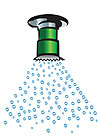
Did you ever wonder what is meant by the termgreen? The term has become commonplace in our vocabulary. But, what really is green?
In plumbing, most people think that green means water and energy conservation. But green is so much more than that.
Green means environmentally friendly in all ways possible. Yes, conserving water is green. Conserving energy is also green. Using materials made from renewable sources is green. Employing materials that use less energy to produce is green. So are products that don’t pollute the environment. Whether it is water pollution or air pollution, it is green to prevent or reduce pollution.
Anything that can extend our lives or prevent disease is also green. We not only want to protect the Earth, we want to protect ourselves.
Green Sprinklers
My children have always told me to renew, reuse, recycle and reduce. These are the four Rs of the green movement. This is how we can protect our environment.
A major green building system is residential sprinklers. You may be asking, “How can sprinkler systems be green?”
A residential sprinkler system is a fundamental system with regard to conserving and protecting our environment. The most important function of a residential sprinkler system is to protect lives. These systems maintain tenability in the room of fire origin, to protect the people inside the building.
Saving a life is definitely green.
But more than saving lives, sprinkler systems also reuse and reduce. If there is a fire in a residential unit, the sprinkler system activates, flowing water onto the fire. The amount of water discharged from the sprinkler is between 8 and 20 gpm, depending on the design and the sprinkler. The quick activation of residential sprinklers makes it possible for a low flow of water to control the fire.
If sprinklers were not installed in a residential building, the amount of water required to fight the fire would far exceed the amount of water discharging from the sprinkler system. The fire department will spray water on the fire at a rate of anywhere from 90 to 160 gpm. That is for each hose. In many residential fires, there are multiple hose lines used to fight the fire.
A fire also would grow in size in a nonsprinklered building. That means even more water would be needed to fight the fire. Plus, the firefighting operation will take longer to put out the fire when it is larger.
So clearly, residential sprinklers conserve water.
If a residential building is not protected by residential sprinklers, the fire consumes the building and the contents of the building. The residential building would have to be reconstructed, using additional building materials and products. Valuable resources would be used to replace the contents and clothing.
When the fire is contained and extinguished, the building is conserved, as are the building contents. There is no need to replace the building products. So clearly, residential sprinkler conserve our natural resources.
The fire in a residential building not protected by sprinklers burns very inefficiently. Smoke escapes into the environment. The smoke includes many pollutants from various products. The smoke discharges greenhouse gases, as well as carcinogens. This smoke damages the environment.
So clearly, residential sprinklers are a green building system.
Look At The Big Picture
So often we look at the small things in trying to analyze whether something is green. We also have to look at the big picture to evaluate whether something is green. Residential sprinklers are part of the big picture.
I will go further to state that plumbing-based residential sprinkler systems are even greener. NFPA 13D permits multipurpose piping systems for residential sprinkler installations. These systems use the cold water distribution system for the residential sprinkler system.
A multipurpose piping system reduces the amount of piping required for the sprinkler and water distribution system. Reducing is green.
The system also reuses the cold water piping system as a residential sprinkler system. Reuse is green.
So, in many ways, a multipurpose piping system is the ultimate green residential sprinkler system. That is not to downplay the fact that any sprinkler system is green. I don’t mean to insinuate that a stand-alone residential sprinkler system is any less green than a multipurpose piping system. They are all green because of their conservation, reduction in pollution and life-saving features.
The U.S. Green Building Council needs to address LEED points for residential sprinkler systems. A sprinkler system meets the requirements outlined by USGBC for being a green building. So points are well-deserved for sprinklered buildings.
Homebuilders are putting a major push on making homes green. This is a great marketing strategy, since everyone is becoming more conscious of the need to be green. Furthermore, everyone knows that being green may mean a slightly higher price for the home. But that is OK, since being green helps everyone.
Contractors are always asking me how they can become more green, especially in the housing market. Well, a residential sprinkler system is one of many ways of being green. It is a great marketing strategy for all of you to promote residential sprinklers as a green building system. Sell it to the homebuilders this way, and sell it to the public.
In many ways, you have a double whammy selling residential sprinklers: The system is green and the system will save lives. How can you do any better than that?
